Komoren |
|
|
|
| Übersicht – Contents: | |
Komoren |
|
|
|
| Übersicht – Contents: | |
Flagge – Flag: |
|
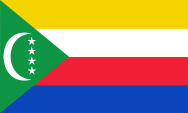 |
ab/from 2002, Nationalflagge – national flag, Seitenverhältnis – ratio = 3:5, Quelle/Source, nach/by: Wikipedia (DE)   |
historische Flaggen – historical Flags: |
|
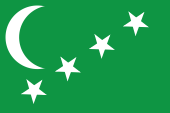 |
13.07.1963–12.11.1975, |
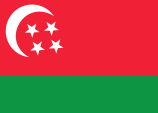 |
12.11.1975–23.05.1978, |
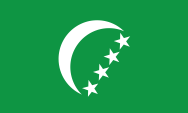 |
24.05.1978–07.06.1992, |
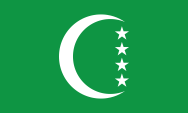 |
ca. 1982, |
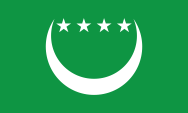 |
07.06.1992–03.10.1996, |
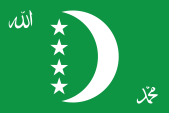 |
03.10.1996–21.01.2002, |
 |
1997–2012, Flagge von Anjouan (Ndzuwani) – flag of Anjouan Quelle/Source, nach/by: Wikipedia (D) |
regionale Flaggen – regional Flags: |
|
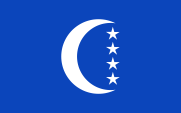 |
Grande Comore (Njazidja) |
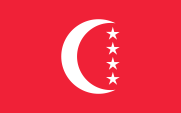 |
Anjouan (Ndzuwani) |
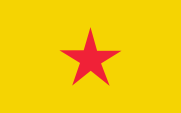 |
Mohéli (Mwali) |
Bedeutung/Ursprung der Flagge – Meaning/Origin of the Flag: |
|
| Die heutige Flagge der Komoren wurde am 21.01.2002 eingeführt. Sie zeigt vier gleich breite waagerechte Streifen in Gelb, Weiß, Rot und Blau. Am Liek befindet sich ein grünes Dreieck mit einem Halbmond und vier Sternen. Eine Definition der Farben der Flagge liegt nicht vor, lediglich die Farbwerte, die anlässlich der Olympiade 2012 vom Int. Olympischen Kommitee hinterlegt wurden: Grün = Pantone 355, Gelb = Pantone 109, Rot = Pantone 32, Blau = Pantone 293. | The today's flag of the Comoros was introduced on 21st of January in 2002. It shows four same-wide horizontal stripes in yellow, white, red and blue. On the leech is positioned a green triangle with a half-moon and four stars. There is no definition of the colors of the flag, only the color values that were deposited by the International Olympic Committee on the occasion of the 2012 Olympics: green = Pantone 355, yellow = Pantone 109, red = Pantone 32, blue = Pantone 293. |
| Das grüne Dreieck sowie Halbmond und Sterne erinnern an die bisherigen Flaggen der Komoren. Die Flagge der Komoren bestand nämlich ursprünglich aus einem grünen Tuch, darauf ein weißer Halbmond und vier Sterne. Die grüne Grundfarbe und der Halbmond symbolisieren den Islam, die Sterne die vier Hauptinseln des Archipels. Die Farben Gelb, Weiß, Rot und Blau in den vier Streifen im wehenden Teil der Flagge stehen ebenfalls für die vier Hauptinseln der Komoren. | The green
triangle as well the half-moon and the stars remember the hitherto valid
flags of the Comoros. The flag of the Comoros had initially consisted in a green bunting, on it a white half-moon and four stars. The green colour and the half-moon symbolize the islam, the stars the four main islands of the archipelago. The colours yellow, white, red and blue in the four stripes in the flying part of the flag stand likewise for the four main islands of the Comoros. |
| Die erste Flagge für die französische Kolonie der Komoren wurde im Jahre 1963 eingeführt. | The first flag for the French colony of the Comoros was introduced in 1963. |
| Anlässlich der VN-Mitgliedschaft wurde 1975 eine Flagge mit einem schmalen roten Streifen am unteren Ende eingeführt. Nach zahlreichen Machtwechseln wurden immer wieder andere Flaggen eigeführt, der Mond und die Sterne drehten sich in unterschiedlichste Richtungen, wurden in unterschiedlichster Weise gruppiert und angeordnet. Zuletzt wurden sogar noch arabische Schriftzeichen ergänzt. Sie bedeuteten "Allah", und "Mohammed". | On the
occasion of the UN-membership in 1975, was introduced a flag with a narrow
red stripe on the lower end. After numerous changes of government were introduced other flags, the moon and the stars turned in different directions, were grouped and arranged in varying ways. Finally were even added Arabic letters. They meaned "Allah" and "Mohammed". |
| Quelle/Source: Die Welt der Flaggen, Flags of the World, Wikipedia (DE) | |
Wappen – Coat of Arms: |
|
 |
bis/until 1978, Wappen der Komoren – coat of arms of the Comoros, Quelle/Source: Thommy [CC0], via Wikimedia Commons |
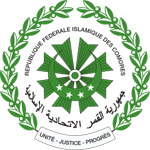 |
1978–2001, Wappen der Komoren – coat of arms of the Comoros, Quelle/Source: Tonyjeff, based on national symbol, with the help of users AnonMoos, Kafka1, Omar86 and زهير حرب. [Public domain], via Wikimedia Commons |
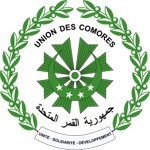 |
ab/from 2016, Wappen der Komoren – coat of arms of the Comoros, Quelle/Source: Tonyjeff, based on national symbol, with the help of users AnonMoos, Kafka1, Omar86, زهير حرب and Thommy. [Public domain], via Wikimedia Commons |
Bedeutung/Ursprung des Wappens – Meaning/Origin of the Coat of Arms: |
|
| Das erste und von 1975 bis 1978 gültige Staatswappen der Komoren zeigte neben dem Namen des Staates einen fünfstrahligem Stern auf einem liegenden Halbmond, umgeben von einem Kranz aus vielen Sternen. | The first and from 1975 to 1978 valid coat of arms of the Comoros showed besides an five-pointed star placed on an lying half-moon surrounded by a wreath of many stars. |
| Das von 1978 bis 2001 gültige Staatswappen der Komoren zeigte den liegenden Halbmond belegt mit vier Sternen auf einem achtstrahligen Stern, umgeben vom Landesnamen (Islamische Bundesrepublik Komoren) in Französich und Komorisch (arabisch geschrieben), einem Kranz aus Olivenzweigen und ein Spruchband mit dem Motto des Landes in französich: "Unité, Justice, Progress" → "Einigkeit, Gerechtigkeit, Fortschritt". | The between 1978 and 2001 valid coat of arms of the Comoros showed the lying crescent with four stars on it, placed on an eight-pointed star, surrounded by the name of the country (Federal Islamic Republic of Comoros) in French and Comorian (written in Arabic), a wreath from Olive branches and a banner with the motto of the state in French: "Unité, Justice, Progress" → "Unity, Justice, Progress". |
| Im Jahre 2016 wurde der Staatsname geändert (Union der Komoren) und auch das Motto. Es lautet jetzt: "Unité, Solidarité, Développement" → "Einigkeit, Solidarität, Entwicklung". | In 2016, the name of the state was changed (Union of the Comoros) and also the motto. It now reads: "Unité, Solidarité, Développement" → "Unity, Solidarity, Development". |
| Quelle/Source: Flaggen Wappen Hymnen, Wikipedia (DE) | |
Landkarten – Maps: |
Die Lage der Komoren – position of the Comoros: |
Komoren – Comoros: |
Zahlen und Fakten – Numbers and Facts: |
|
|
|
|
|
|
|
|
|
|
|
|
|
|
|
|
|
|
|
|
Geschichte: |
|
ca 600
· beginnende Besiedelung durch Melanesier, Polynesier, Afrikaner und Perser 1416 · die Araber erobern die Inseln, in der Folgezeit Islamisierung 1500–1505 · die Portugiesen beherrschen die Komoren 1506 · Einigung der Inseln unter einem arabischen Sultan, später zerfällt der Staat, und jede einzelne Insel wird von einem Sultan regiert ca. 1700 · Madagaskar versucht die Inseln zu erobern, die Inseln werden ein Zentrum der Piraterie 1803 · Ansiedlung von aus Frankreich vertriebenen Jakobinern 1841 · die Insel Mayotte wird auf Betreiben des Sultans von Mayotte ein französisches Protektorat und von Réunion aus verwaltet 1849–1873 · französische Kolonisierung auf allen Inseln der Komoren 1886 · das französische Protektorat wird auf alle Komoren-Inseln ausgedehnt 1909 · die Komoren werden französische Kolonie und von Französisch-Madagaskar aus verwaltet 1946 · die Komoren werden französisches Überseeterritorium mit eigener Verwaltung 1958 · eine Volksabstimmung für Unabhängigkeit von Frankreich scheitert 1961 · die Komoren erhalten innere Selbstverwaltung 1975 · Unabhängigkeitserklärung der Regierung der Komoren – gegen den Widerstand der Komorer, die zumeist bei Frankreich verbleiben wollen 1976 · eine Volksabstimmung auf Mayotte erreicht den Verbleib der Insel bei Frankreich 1977 · die Komoren erhalten eine sozialistische Verfassung 1978 · Sturz der Regierung durch französische und belgische Söldner, neue Verfassung, neue Staatsbezeichnung: Islamische Bundesrepublik Komoren 1979 · Einparteiensystem 1990 · freie und demokratische Wahlen im Mehrparteiensystem 1990–1996 · wechselnde Staatschefs und Putsche 1996 · neue Verfassung 1997 · die Inseln Anjouan und Mohéli erklären sich für unabhängig 1999 · die Insel Anjouan lehnt ein Autonomieangebot ab, Militärputsch auf den (Rest-)Komoren 2000 · eine Volksabstimmung auf Anjouan, stimmt gegen einen Friedensplan der OAU und für staatliche Unabhängigkeit 2001 · neue Verfassung, die Inseln Anjouan und Mohéli kehren in den Staatsverband zurück, neue Staatsbezeichnung: Islamische Union der Komoren 2016 · neue Staatsbezeichnung: Union der Komoren |
History: |
|
ca. 600
· beginning settlement by Melanesians, Polynesians, Africans and Persians 1416 · the Arabs conquer the islands, in the afteryears islamization 1500–1505 · the Portugese rule over the Comoros 1506 · unification of the islands under an Arabic Sultan, later the state disintegrates and every single island is ruled by one Sultan ca. 1700 · Madagascar tryes to conquer the islands, the islands become a center of the piracy 1803 · settle of from France exiled Jacobins 1841 · Mayotte Island becomes a French protectorate by deliberation of the Sultan of Mayotte and the island becomes administered from Réunion Island 1849–1873 · French colonization on all islands of the Comoros 1886 · the French protectorate gets expanded over all Comoro Islands 1909 · the Comoros become a French colony and get administered from French Madagascar 1946 · the Comoros become a French Overseas Territory with own administration 1958 · a plebiscite for independence from France fails 1961 · the Comoros get interior self government 1975 · declaration of independenceby the government of the Comoros – against the resistance of the Comorians, which mostly want to remain at France 1976 · a plebiscite on Mayotte achieves the remain of the island at France 1977 · the Comoros get a socialistic constitution 1978 · overthrow of the government by French and Belgian mercenaries, new constitution, new designation of the state: Islamic Federal Republic of the Comoros 1979 · one-party-system 1990 · free and democratic elections within a multi-party-system 1990–1996 · varying chiefs of state and coups d'état 1996 · new constitution 1997 · Anjouan Island and Mohéli Island declare itself for independent 1999 · Anjouan Island rejects an offer for autonomy, military coup d'état on the (remainding) Comoros 2000 · a plebiscite on Anjouan votes against a plan for peace of the OAU and for state independence 2001 · new constitution, the islands of Anjouan and Moheli return into the state, new name of the state: Islamic Union of the Comoros 2016 · new name of the state: Union of the Comoros |
| Quelle/Source: Atlas zur Geschichte, Wikipedia (D), World Statesmen |
Ursprung des Landesnamens – Origin of the Country's Name: |
|
| Der Name des Landes kommt aus der Arabischen Sprache. Die Araber nannten die Inseln "dschuzur al-qamar", was übersetzt "Mondinseln" heißt. | The name of the country comes from the Arabic language. The Arabs called the islands "dschuzur al-qamar", which is to translate as "Moon Islands". |
| Quelle/Source: Atlas der wahren Namen | |